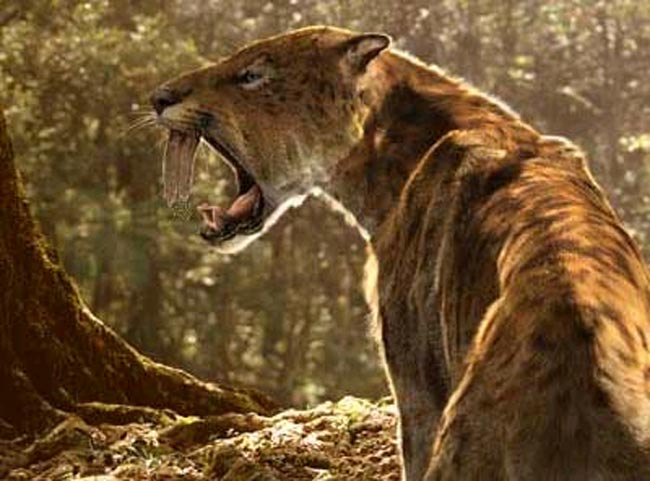Study Paints Sabertooths as Relative Pussycats

Though their long teeth look fearsome, male sabertooth cats may have actually been less aggressive than their feline cousins, a new study finds.
Commonly called the sabertoothed tiger, Smilodon fatalis was a large predatory cat that roamed North and South America about 1.6 million to 10,000 years ago, when there was also a prehistoric cat called the American lion. The study examined size differences between sexes of these large felines using clues from bones and teeth.
The researchers report that while male American lions were considerably larger than females, male and female sabertoothed cats were indistinguishable in size. Since size differences between the sexes tend to be more impressive in species where male aggression is more intense, the findings suggest that male sabertooths may have been less aggressive than male American lions.
In species where males fight for mates, bigger, heavier males have a better chance of winning fights, fending off their rivals and gaining access to females. After generations of male-male competition, the males of some species evolve to be much larger than their mates.
Judging size from the fossil record can be tricky since the cats grow as they age, and it's easy to get a younger, smaller male confused with an older, larger female, said study co-author Julie Meachen-Samuels, a biologist at the National Evolutionary Synthesis Center in Durham, N.C. So the researchers turned to fossilized teeth to help them account for the continued growth.
"Teeth fill in over time," said Wendy Binder of Loyola Marymount University in Los Angeles, CA. "In young animals the tooth cavity is basically hollow, but as they get older it fills in with dentin. It won't give you an exact age, but it can give you a relative age in terms of young, middle-aged or old."
Meachen-Samuels and Binder X-rayed the lower teeth and jaws of 13 American lions and 19 sabertoothed cats recovered from the La Brea Tar Pits in Los Angeles, a spot known for preserving prehistoric fossils. They measured tooth cavity diameter and plotted it against jaw length for each species to account for growth. Plotted this way, the data for the American lion fell easily into two groups, regardless of age.
Sign up for the Live Science daily newsletter now
Get the world’s most fascinating discoveries delivered straight to your inbox.
In contrast, sabertoothed cat sizes seemed to be governed solely by age. It would appear that the males were indistinguishable from their mates. "Even by incorporating a measure of age, you can't distinguish males and females," said Meachen-Samuels.
This isn't the first time the ferociousness of sabertooths has been called into question. A 2007 study found that the large cat's bite was relatively wimpy when compared to that of a lion.
Based on their findings, the researchers think the American lion probably lived in male-dominated groups, where one to two males monopolized and mated with multiple females. But with sabertooths, the living situation may have been different. "Rather than males having harems of females, the males and females in a group might have been more equal," Binder said.
The study was published in the Nov. 5 issue of the Journal of Zoology.
- Video: White Lion Pride
- Sabertooth Cat Had Whimpy Bite
- Sabertooth 'Tigers' Were Social Beasts











